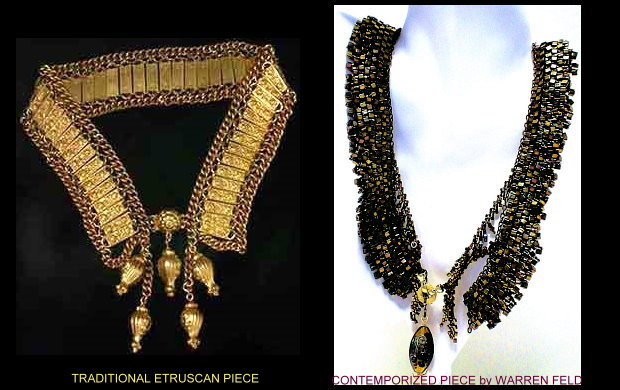The
COLLECTIONS
Contemporized Etruscan Jewelry

CONTEMPORIZING TRADITIONAL JEWELRY
What does it mean “to contemporize”? If you walked into a Museum of Contemporary Art, you would find some things that were abstract, but other things that were realistic or impressionistic or surrealistic. You would find a lot of individualized expression – works associated with a particular artist, rather than a particular culture. You would find a wide use of modern materials and techniques and technologies. You would find unusual or especially noteworthy assemblages of pieces or colors or textures. You would find pieces that in some way reflect modern culture and sensibilities – fashions, styles, purposes, statements. The exhibits would change on a regular basis, and you would also find something new and different to experience and marvel at each time.
Traditional Art, on the other hand, suppressed individualized expression. Instead, whatever the art form, traditional art emphasized a restatement of its cultural narrative. That is, artists, working within that cultural tradition, would use similar materials, similar designs, and similar motifs. The artwork was a symbolic representation of that culture’s values and self-image. The “doing of the artwork” was a reaffirmation of one’s place within that culture. Simply, if you did the same kinds of things in the same kinds of ways as everyone else, this reaffirmed your membership within that group and culture. And if you visited a Museum of Traditional Art, there would be many displays of wonderful, sometimes elaborate, pieces, but the exhibits would never have to change.
Contemporizing Traditional Jewelry has to do with how you take these particular forms and techniques, and both add your personal style to the pieces, as well as make them more relevant to today’s sense of fashion and style. This may be trickier than it might first appear. To what degree should you reference the traditional design elements in your contemporary piece? Just the colors? The colors and the pattern? The stitching, stringing or other techniques? The structural components, as well? How do you break down the traditional piece, in order to better understand it? And how do you use this understanding to figure out how and what you should manipulate, as you design and construct your contemporary piece?
There is considerable artistry and craftsmanship underlying Etruscan jewelry. They brought to their designs clever techniques of texturing, ornamentation, color, relief, filigree, granulation and geometric, floral and figurative patterning. While their techniques were borrowed from the Greeks and other Mediterranean cultures, the Etruscans perfected these to a level of sophistication not seen before, and not often even today.
Here Warren uses an understanding of good jewelry design principles, and how they help us manipulate elements of design, to begin to develop a framework for contemporizing traditional Etruscan jewelry. He uses both bead stringing as well as bead weaving techniques toward this end.
--- Warren Feld

